-
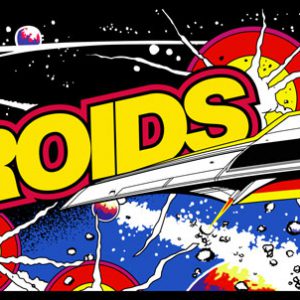 Yet another legendary, genre-defining game – in an era replete with genre-defining classics - in which a single player takes control of a ship trapped in the middle of an asteroid field. A number of large, slow-moving asteroids drift randomly around the play area and must be shot by the player. When shot, the asteroids will break into a number of smaller pieces, which must also be shot until, eventually, all of the asteroids and fragments will be destroyed and the next wave begins. Asteroids introduced real-world physics to video games for the first time, with speed and inertia all adding to the player’s problems. As well as the inertia of the player’s ship – forcing the player to allow for the ship slowing down and speeding up whenever the thrust button was utilized – shot asteroids would often send fragments flying in seemingly random directions, and at varying and unpredictable speeds. As well as the ever-present asteroids, alien saucers also make a regular appearance. These move diagonally around the screen, firing at the player’s ship and must be quickly destroyed.
Yet another legendary, genre-defining game – in an era replete with genre-defining classics - in which a single player takes control of a ship trapped in the middle of an asteroid field. A number of large, slow-moving asteroids drift randomly around the play area and must be shot by the player. When shot, the asteroids will break into a number of smaller pieces, which must also be shot until, eventually, all of the asteroids and fragments will be destroyed and the next wave begins. Asteroids introduced real-world physics to video games for the first time, with speed and inertia all adding to the player’s problems. As well as the inertia of the player’s ship – forcing the player to allow for the ship slowing down and speeding up whenever the thrust button was utilized – shot asteroids would often send fragments flying in seemingly random directions, and at varying and unpredictable speeds. As well as the ever-present asteroids, alien saucers also make a regular appearance. These move diagonally around the screen, firing at the player’s ship and must be quickly destroyed. -
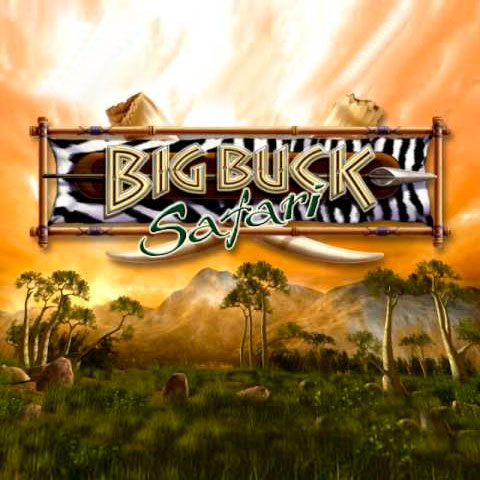
-
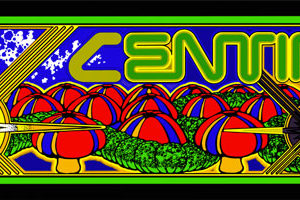 Centipede is a vertically oriented shoot ‘em up arcade game produced by Atari, Inc. in 1981. The game was designed by Ed Logg along with Dona Bailey, one of the few female game programmers in the industry at this time. It was also one of the first arcade coin-operated games to have a significant female player base, after Pac-Man. The player defends against centipedes, spiders, scorpions and fleas, completing a round after eliminating the centipede that winds down the playing field. The player is represented by a small, “somewhat humanoid head” at the bottom of the screen. The player moves the character about the bottom area of the screen with a trackball and fires laser shots at a centipede advancing from the top of the screen down through a field of mushrooms. Shooting any section of the centipede creates a mushroom; shooting one of the middle segments splits the centipede into two pieces at that point. Each piece then continues independently on its way down the board, with the first section of the rear piece becoming a new head. If the head is destroyed, the section behind it becomes the next head. The centipede starts at the top of the screen, traveling either left or right. When it hits a mushroom or the edge of the screen, it drops one level and switches direction. Thus, more mushrooms on the screen cause the centipede to descend more rapidly. The player can destroy mushrooms by shooting them, but each takes four hits to destroy. If the centipede reaches the bottom of the screen, it moves back and forth within the player area and one-segment “head” centipedes are periodically added. This continues until the player has eliminated both the original centipede and all heads. When all the centipede’s segments are destroyed, a new centipede forms at the top of the screen. Every time a centipede is eliminated, however, the next one is one segment shorter and is accompanied by one additional, fast-moving “head” centipede. A player loses a life when hit by a centipede or another enemy, such as a spider or a flea. The flea leaves mushrooms behind when fewer than five are in the player area, though the number required increases with level of difficulty. Spiders move across the player area in a zig-zag fashion and occasionally eat some of the mushrooms. Scorpions poison every mushroom they touch, but these never appear in the player’s movement region. A centipede touching a poisoned mushroom hurtles straight toward the player’s area. Upon reaching the player’s area, the centipede returns to normal behavior.
Centipede is a vertically oriented shoot ‘em up arcade game produced by Atari, Inc. in 1981. The game was designed by Ed Logg along with Dona Bailey, one of the few female game programmers in the industry at this time. It was also one of the first arcade coin-operated games to have a significant female player base, after Pac-Man. The player defends against centipedes, spiders, scorpions and fleas, completing a round after eliminating the centipede that winds down the playing field. The player is represented by a small, “somewhat humanoid head” at the bottom of the screen. The player moves the character about the bottom area of the screen with a trackball and fires laser shots at a centipede advancing from the top of the screen down through a field of mushrooms. Shooting any section of the centipede creates a mushroom; shooting one of the middle segments splits the centipede into two pieces at that point. Each piece then continues independently on its way down the board, with the first section of the rear piece becoming a new head. If the head is destroyed, the section behind it becomes the next head. The centipede starts at the top of the screen, traveling either left or right. When it hits a mushroom or the edge of the screen, it drops one level and switches direction. Thus, more mushrooms on the screen cause the centipede to descend more rapidly. The player can destroy mushrooms by shooting them, but each takes four hits to destroy. If the centipede reaches the bottom of the screen, it moves back and forth within the player area and one-segment “head” centipedes are periodically added. This continues until the player has eliminated both the original centipede and all heads. When all the centipede’s segments are destroyed, a new centipede forms at the top of the screen. Every time a centipede is eliminated, however, the next one is one segment shorter and is accompanied by one additional, fast-moving “head” centipede. A player loses a life when hit by a centipede or another enemy, such as a spider or a flea. The flea leaves mushrooms behind when fewer than five are in the player area, though the number required increases with level of difficulty. Spiders move across the player area in a zig-zag fashion and occasionally eat some of the mushrooms. Scorpions poison every mushroom they touch, but these never appear in the player’s movement region. A centipede touching a poisoned mushroom hurtles straight toward the player’s area. Upon reaching the player’s area, the centipede returns to normal behavior. -
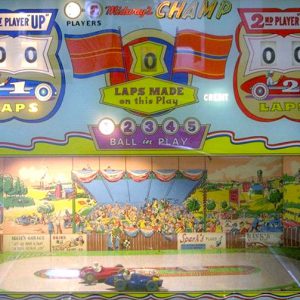
-
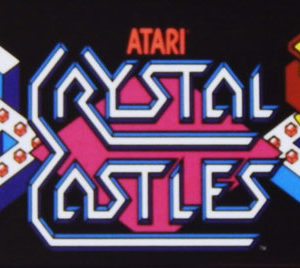 Crystal Castles has nine levels with four castles each, and a tenth level which features a single castle — the clearing of which ends the game. Each of the 37 trimetric-projected castles consists of a maze of hallways filled with gems and bonus objects, and also includes stairs, elevators and tunnels that the player can use as shortcuts. The three-letter initials of the player with the highest score are used to form the first level’s castle structure. When all gems in a castle have been collected, the player moves on to the next castle. The player can also skip some castles and acquire additional lives and points by using secret warps activated by making Bentley Bear jump at special locations. A trackball and “jump” button are used for controlling Bentley Bear’s motions. Gems are collected by simply walking over them, and a bonus is given upon collection of the last gem. While collecting gems, there are a number of enemies that try to stop Bentley and/or collect the gems for themselves. With two exceptions, if touched by the enemies he will lose one of his lives. Any gems collected by the enemies also result in a lower obtainable score for that screen. Likewise, if the last available gem is collected by the enemy, the player also loses the last gem bonus. Enemies can be avoided by use of the maze and its constructs, or by making Bentley jump over opponents with the jump button, in some cases also allowing him to stun them. Some types of enemies will track Bentley’s movements in certain ways, while others move at random. If Bentley is touched, he “cries out” in a distinctive manner with the use of a cartoonish word balloons. If 3 or more lives remain, he says “BYE!”; if 2 lives still remain, the quotation is “OH NO!”; if 1 life is left, it is “OUCH!”; and finally, for the last lost life (which ends the game), he says “#?!”, so as to imitate an obscenity. At the beginning of every maze, gems are worth 1 point each; this value increases by 1 for every gem Bentley picks up, to a maximum of 99. Each maze also randomly includes a hat or honey pot, which serve the dual purpose of awarding points and providing Bentley with the ability to defeat specific enemies. The hat is worth 500 points and will make Bentley invulnerable for a few seconds and allow him to eliminate Berthilda the witch, who appears in the last maze of each level. The honey pot is worth 1,000 points, and picking it up can delay the landing of a swarm of bees. Other villains present in the game include: “Nasty Trees” which become more ornery as levels progress, a ghost that will usually appear in the Hidden Spiral levels, dancing skeletons, “Gem Eaters” who Bentley Bear can defeat if he catches them while eating a gem, and also the devilish “Crystal Balls” creatures that in later levels tend to follow Bentley Bear persistently as he collects gems. The Nasty Trees and Crystal Balls can also pick up gems. Crystal Castles contains two notable easter eggs. Jumping 100 times or more in the southeast corner of level 1?1 and clearing the maze of all gems will make ATARI appear on level 1?2.[2] On level 5?4, if the player kills Berthilda and goes to the corner of the area where she was and jumps, “FXL” will appear in the southeast corner of the screen. These are the initials for Franz X. Lanzinger, a designer of Crystal Castles.
Crystal Castles has nine levels with four castles each, and a tenth level which features a single castle — the clearing of which ends the game. Each of the 37 trimetric-projected castles consists of a maze of hallways filled with gems and bonus objects, and also includes stairs, elevators and tunnels that the player can use as shortcuts. The three-letter initials of the player with the highest score are used to form the first level’s castle structure. When all gems in a castle have been collected, the player moves on to the next castle. The player can also skip some castles and acquire additional lives and points by using secret warps activated by making Bentley Bear jump at special locations. A trackball and “jump” button are used for controlling Bentley Bear’s motions. Gems are collected by simply walking over them, and a bonus is given upon collection of the last gem. While collecting gems, there are a number of enemies that try to stop Bentley and/or collect the gems for themselves. With two exceptions, if touched by the enemies he will lose one of his lives. Any gems collected by the enemies also result in a lower obtainable score for that screen. Likewise, if the last available gem is collected by the enemy, the player also loses the last gem bonus. Enemies can be avoided by use of the maze and its constructs, or by making Bentley jump over opponents with the jump button, in some cases also allowing him to stun them. Some types of enemies will track Bentley’s movements in certain ways, while others move at random. If Bentley is touched, he “cries out” in a distinctive manner with the use of a cartoonish word balloons. If 3 or more lives remain, he says “BYE!”; if 2 lives still remain, the quotation is “OH NO!”; if 1 life is left, it is “OUCH!”; and finally, for the last lost life (which ends the game), he says “#?!”, so as to imitate an obscenity. At the beginning of every maze, gems are worth 1 point each; this value increases by 1 for every gem Bentley picks up, to a maximum of 99. Each maze also randomly includes a hat or honey pot, which serve the dual purpose of awarding points and providing Bentley with the ability to defeat specific enemies. The hat is worth 500 points and will make Bentley invulnerable for a few seconds and allow him to eliminate Berthilda the witch, who appears in the last maze of each level. The honey pot is worth 1,000 points, and picking it up can delay the landing of a swarm of bees. Other villains present in the game include: “Nasty Trees” which become more ornery as levels progress, a ghost that will usually appear in the Hidden Spiral levels, dancing skeletons, “Gem Eaters” who Bentley Bear can defeat if he catches them while eating a gem, and also the devilish “Crystal Balls” creatures that in later levels tend to follow Bentley Bear persistently as he collects gems. The Nasty Trees and Crystal Balls can also pick up gems. Crystal Castles contains two notable easter eggs. Jumping 100 times or more in the southeast corner of level 1?1 and clearing the maze of all gems will make ATARI appear on level 1?2.[2] On level 5?4, if the player kills Berthilda and goes to the corner of the area where she was and jumps, “FXL” will appear in the southeast corner of the screen. These are the initials for Franz X. Lanzinger, a designer of Crystal Castles. -
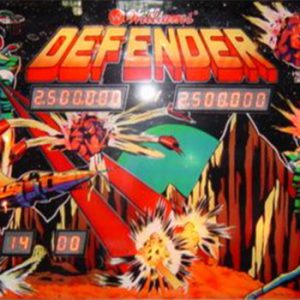 Defender is an arcade video game developed and released by Williams Electronics in 1980. A shooting game featuring two-dimensional (2D) graphics, the game is set on a fictional planet where the player must defeat waves of invading aliens while protecting astronauts. Development was led by Eugene Jarvis, a pinball programmer at Williams; Defender was Jarvis’ first video game project, and drew inspiration from Space Invaders and Asteroids. Defender is a two-dimensional side-scrolling shooting game set on the surface of an unnamed planet. The player controls a space ship as it navigates the terrain, flying either to the left or right. A joystick controls the ship’s elevation, and five buttons control its horizontal direction and weapons. The object is to destroy alien invaders, while protecting astronauts on the landscape from abduction. Humans that are successfully abducted return as mutants that attack the ship. Defeating the aliens allows the player to progress to the next level. Failing to protect the astronauts, however, causes the planet to explode and the level to become populated with mutants. Surviving the waves of mutants results in the restoration of the planet. Players are allotted three chances (lives) to progress through the game and are able to earn more by reaching certain scoring benchmarks. A life is lost if the ship comes into contact with an enemy or its projectiles. After exhausting all lives, the game ends. Defender is an arcade video game developed and released by Williams Electronics in 1980. A shooting game featuring two-dimensional (2D) graphics, the game is set on a fictional planet where the player must defeat waves of invading aliens while protecting astronauts. Development was led by Eugene Jarvis, a pinball programmer at Williams; Defender was Jarvis’ first video game project and drew inspiration from Space Invaders and Asteroids. Defender was one of the most important titles of the Golden Age of Arcade Games, selling over 55,000 units to become the company’s best selling game and one of the highest-grossing arcade games ever. Praise among critics focused on the game’s audio-visuals and gameplay. It is frequently listed as one of Jarvis’ best contributions to the video game industry as well as one of the most difficult video games. Defender was ported to numerous platforms, inspired the development of other games, and was followed by sequels and many imitations. Defender is a two-dimensional side-scrolling shooting game set on the surface of an unnamed planet. The player controls a space ship as it navigates the terrain, flying either to the left or right. A joystick controls the ship’s elevation, and five buttons control its horizontal direction and weapons. The object is to destroy alien invaders while protecting astronauts on the landscape from abduction. Humans who are successfully abducted return as mutants that attack the ship. Defeating the aliens allows the player to progress to the next level. Failing to protect the astronauts, however, causes the planet to explode and the level to become populated with mutants. Surviving the waves of mutants results in the restoration of the planet. Players are allotted three chances (lives) to progress through the game and are able to earn more by reaching certain scoring benchmarks. A life is lost if the ship comes into contact with an enemy or its projectiles. After exhausting all lives, the game end.
Defender is an arcade video game developed and released by Williams Electronics in 1980. A shooting game featuring two-dimensional (2D) graphics, the game is set on a fictional planet where the player must defeat waves of invading aliens while protecting astronauts. Development was led by Eugene Jarvis, a pinball programmer at Williams; Defender was Jarvis’ first video game project, and drew inspiration from Space Invaders and Asteroids. Defender is a two-dimensional side-scrolling shooting game set on the surface of an unnamed planet. The player controls a space ship as it navigates the terrain, flying either to the left or right. A joystick controls the ship’s elevation, and five buttons control its horizontal direction and weapons. The object is to destroy alien invaders, while protecting astronauts on the landscape from abduction. Humans that are successfully abducted return as mutants that attack the ship. Defeating the aliens allows the player to progress to the next level. Failing to protect the astronauts, however, causes the planet to explode and the level to become populated with mutants. Surviving the waves of mutants results in the restoration of the planet. Players are allotted three chances (lives) to progress through the game and are able to earn more by reaching certain scoring benchmarks. A life is lost if the ship comes into contact with an enemy or its projectiles. After exhausting all lives, the game ends. Defender is an arcade video game developed and released by Williams Electronics in 1980. A shooting game featuring two-dimensional (2D) graphics, the game is set on a fictional planet where the player must defeat waves of invading aliens while protecting astronauts. Development was led by Eugene Jarvis, a pinball programmer at Williams; Defender was Jarvis’ first video game project and drew inspiration from Space Invaders and Asteroids. Defender was one of the most important titles of the Golden Age of Arcade Games, selling over 55,000 units to become the company’s best selling game and one of the highest-grossing arcade games ever. Praise among critics focused on the game’s audio-visuals and gameplay. It is frequently listed as one of Jarvis’ best contributions to the video game industry as well as one of the most difficult video games. Defender was ported to numerous platforms, inspired the development of other games, and was followed by sequels and many imitations. Defender is a two-dimensional side-scrolling shooting game set on the surface of an unnamed planet. The player controls a space ship as it navigates the terrain, flying either to the left or right. A joystick controls the ship’s elevation, and five buttons control its horizontal direction and weapons. The object is to destroy alien invaders while protecting astronauts on the landscape from abduction. Humans who are successfully abducted return as mutants that attack the ship. Defeating the aliens allows the player to progress to the next level. Failing to protect the astronauts, however, causes the planet to explode and the level to become populated with mutants. Surviving the waves of mutants results in the restoration of the planet. Players are allotted three chances (lives) to progress through the game and are able to earn more by reaching certain scoring benchmarks. A life is lost if the ship comes into contact with an enemy or its projectiles. After exhausting all lives, the game end. -
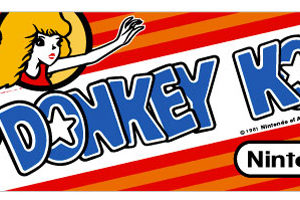 Donkey Kong is an arcade game released by Nintendo in 1981. It is an early example of the platform game genre, as the gameplay focuses on maneuvering the main character across a series of platforms while dodging and jumping over obstacles. In the game, Jumpman (since renamed Mario) must rescue a damsel in distress, Lady (now named Pauline), from a giant ape named Donkey Kong. The hero and ape later became two of Nintendo’s most popular characters. Donkey Kong is one of the earliest examples of the platform game genre; it is sometimes said to be the first platform game, although it was preceded by Space Panic. In contrast to Space Panic, however, Donkey Kong was the first platform game to feature jumping, introducing the need to jump between gaps and over obstacles or approaching enemies, setting the template for the platform genre. Competitive video gamers and referees stress the game’s high level of difficulty compared to other classic arcade games. Winning the game requires patience and the ability to accurately time Jumpman’s ascent. In addition to presenting the goal of saving the Lady, the game also gives the player a score. Points are awarded for finishing screens; leaping over obstacles; destroying objects with a hammer power-up; collecting items such as hats, parasols, and purses (apparently belonging to the Lady/Pauline); and completing other tasks. The player typically receives three lives with a bonus awarded for the first 7,000 points, although this can be modified via the game’s built in DIP switches. The game is divided into four different one-screen stages. Each represents 25 meters of the structure Donkey Kong has climbed, one stage being 25 meters higher than the previous. The final screen occurs at 100 m. Later ports of the game omit or change the sequence of the screens. The original arcade version includes: Screen 1 (25 m), Jumpman must scale a seven-story construction site made of crooked girders and ladders while jumping over or hammering barrels and oil barrels tossed by Donkey Kong. The hero must also avoid fireballs which generate when barrels run into the oil drum at the bottom of the site. Players routinely call this screen “Barrels”. Screen 2 (50 m), Jumpman must climb a five-story structure of conveyor belts, each of which transports cement pans. The fireballs also make another appearance. This screen is sometimes referred to as the “Factory” or “Pie Factory” due to the resemblance of the cement pans to pies. Screen 3 (75 m), Jumpman rides up and down elevators while avoiding fireballs and bouncing objects, presumably spring weights. The bouncing weights (the hero’s greatest danger in this screen) emerge on the top level and drop near the rightmost elevator. The screen’s common name is “Elevators”. This screen appears as an unlockable stage in Super Smash Bros. Brawl. Screen 4 (100 m), Jumpman must remove the eight rivets which support Donkey Kong. The fireballs remain the primary obstacle. Removing the final rivet causes Donkey Kong to fall and the hero to be reunited with Lady/Pauline. This is the final screen of each level. Players refer to this screen as “Rivets”. The player loses a life if: Jumpman collides with a barrel, fireball, flaming oil barrel, spring weight, cement pan, or Donkey Kong himself Jumpman falls off the structure or through open rivet holes The bonus timer reaches 0. These screens combine to form levels, which become progressively tougher. For example, Donkey Kong begins to hurl barrels faster and sometimes diagonally, and fireballs get speedier. The victory music alternates between levels 1 and 2. The 22nd level is unofficially known as the kill screen, due to an error in the game’s programming that kills Mario after a few seconds, effectively ending the game. With its four unique levels, Donkey Kong was the most complex arcade game at the time of its release, and only the second game to feature multiple levels (the first was Gorf by Midway Games).
Donkey Kong is an arcade game released by Nintendo in 1981. It is an early example of the platform game genre, as the gameplay focuses on maneuvering the main character across a series of platforms while dodging and jumping over obstacles. In the game, Jumpman (since renamed Mario) must rescue a damsel in distress, Lady (now named Pauline), from a giant ape named Donkey Kong. The hero and ape later became two of Nintendo’s most popular characters. Donkey Kong is one of the earliest examples of the platform game genre; it is sometimes said to be the first platform game, although it was preceded by Space Panic. In contrast to Space Panic, however, Donkey Kong was the first platform game to feature jumping, introducing the need to jump between gaps and over obstacles or approaching enemies, setting the template for the platform genre. Competitive video gamers and referees stress the game’s high level of difficulty compared to other classic arcade games. Winning the game requires patience and the ability to accurately time Jumpman’s ascent. In addition to presenting the goal of saving the Lady, the game also gives the player a score. Points are awarded for finishing screens; leaping over obstacles; destroying objects with a hammer power-up; collecting items such as hats, parasols, and purses (apparently belonging to the Lady/Pauline); and completing other tasks. The player typically receives three lives with a bonus awarded for the first 7,000 points, although this can be modified via the game’s built in DIP switches. The game is divided into four different one-screen stages. Each represents 25 meters of the structure Donkey Kong has climbed, one stage being 25 meters higher than the previous. The final screen occurs at 100 m. Later ports of the game omit or change the sequence of the screens. The original arcade version includes: Screen 1 (25 m), Jumpman must scale a seven-story construction site made of crooked girders and ladders while jumping over or hammering barrels and oil barrels tossed by Donkey Kong. The hero must also avoid fireballs which generate when barrels run into the oil drum at the bottom of the site. Players routinely call this screen “Barrels”. Screen 2 (50 m), Jumpman must climb a five-story structure of conveyor belts, each of which transports cement pans. The fireballs also make another appearance. This screen is sometimes referred to as the “Factory” or “Pie Factory” due to the resemblance of the cement pans to pies. Screen 3 (75 m), Jumpman rides up and down elevators while avoiding fireballs and bouncing objects, presumably spring weights. The bouncing weights (the hero’s greatest danger in this screen) emerge on the top level and drop near the rightmost elevator. The screen’s common name is “Elevators”. This screen appears as an unlockable stage in Super Smash Bros. Brawl. Screen 4 (100 m), Jumpman must remove the eight rivets which support Donkey Kong. The fireballs remain the primary obstacle. Removing the final rivet causes Donkey Kong to fall and the hero to be reunited with Lady/Pauline. This is the final screen of each level. Players refer to this screen as “Rivets”. The player loses a life if: Jumpman collides with a barrel, fireball, flaming oil barrel, spring weight, cement pan, or Donkey Kong himself Jumpman falls off the structure or through open rivet holes The bonus timer reaches 0. These screens combine to form levels, which become progressively tougher. For example, Donkey Kong begins to hurl barrels faster and sometimes diagonally, and fireballs get speedier. The victory music alternates between levels 1 and 2. The 22nd level is unofficially known as the kill screen, due to an error in the game’s programming that kills Mario after a few seconds, effectively ending the game. With its four unique levels, Donkey Kong was the most complex arcade game at the time of its release, and only the second game to feature multiple levels (the first was Gorf by Midway Games). -
 Donkey Kong Jr. is a 1982 arcade-style platform video game by Nintendo. It first appeared in arcades, and, over the course of the 1980s, was later released for a variety of platforms, most notably the Nintendo Entertainment System. The game’s title is written out as Donkey Kong Junior in the North American arcade version and various ports to non-Nintendo systems. Its eponymous star, Donkey Kong Jr., also called simply Junior[3] or abbreviated as DK Jr.,[4] is trying to rescue his father Donkey Kong, who has been imprisoned. Donkey Kong’s cage is guarded by Mario, in his only appearance as an antagonist in a video game. This game is the sequel to the video game Donkey Kong, which featured Mario as the hero and Junior’s father as the villain. Plot: Mario (known as Jumpman in Donkey Kong) has captured Donkey Kong and placed him in a cage as punishment for kidnapping his girlfriend Pauline.[5] Donkey Kong Jr. must rescue his father from Mario by working his way through a series of stages. Mario attempts to stop DK Jr. by releasing animals and putting obstacles in his way. When DK Jr. succeeds at the final level, Donkey Kong is freed and kicks Mario into the distance, leaving him to an unknown fate. Gameplay Like its predecessor, Donkey Kong, Jr. is an arcade-style platform game. There are a total of four stages, each with a unique theme. DK Jr. can run left and right, jump, and grab vines/chains/ropes to climb higher on the screen. He can slide down faster by holding only one vine, or climb faster by holding two. Enemies include “Snapjaws,” which resemble bear traps with eyes, bird-like creatures called “Nitpickers”, and “Sparks” that roam across the wiring in one of Mario’s hideouts. To pass the first three stages, DK Jr. must reach the key at the top. In the fourth stage, DK Jr. must push six keys into locks near the top of the stage to free Donkey Kong. After a brief cutscene, the player is taken back to the first stage at an increased difficulty. DK Jr. loses a life when he touches any enemy or projectile, falls too great a distance, or falls off the bottom of the screen. Additionally, he loses a life if the timer counts down to zero. The game ends when the player loses all of his or her lives.
Donkey Kong Jr. is a 1982 arcade-style platform video game by Nintendo. It first appeared in arcades, and, over the course of the 1980s, was later released for a variety of platforms, most notably the Nintendo Entertainment System. The game’s title is written out as Donkey Kong Junior in the North American arcade version and various ports to non-Nintendo systems. Its eponymous star, Donkey Kong Jr., also called simply Junior[3] or abbreviated as DK Jr.,[4] is trying to rescue his father Donkey Kong, who has been imprisoned. Donkey Kong’s cage is guarded by Mario, in his only appearance as an antagonist in a video game. This game is the sequel to the video game Donkey Kong, which featured Mario as the hero and Junior’s father as the villain. Plot: Mario (known as Jumpman in Donkey Kong) has captured Donkey Kong and placed him in a cage as punishment for kidnapping his girlfriend Pauline.[5] Donkey Kong Jr. must rescue his father from Mario by working his way through a series of stages. Mario attempts to stop DK Jr. by releasing animals and putting obstacles in his way. When DK Jr. succeeds at the final level, Donkey Kong is freed and kicks Mario into the distance, leaving him to an unknown fate. Gameplay Like its predecessor, Donkey Kong, Jr. is an arcade-style platform game. There are a total of four stages, each with a unique theme. DK Jr. can run left and right, jump, and grab vines/chains/ropes to climb higher on the screen. He can slide down faster by holding only one vine, or climb faster by holding two. Enemies include “Snapjaws,” which resemble bear traps with eyes, bird-like creatures called “Nitpickers”, and “Sparks” that roam across the wiring in one of Mario’s hideouts. To pass the first three stages, DK Jr. must reach the key at the top. In the fourth stage, DK Jr. must push six keys into locks near the top of the stage to free Donkey Kong. After a brief cutscene, the player is taken back to the first stage at an increased difficulty. DK Jr. loses a life when he touches any enemy or projectile, falls too great a distance, or falls off the bottom of the screen. Additionally, he loses a life if the timer counts down to zero. The game ends when the player loses all of his or her lives. -
 Frogger is an arcade game introduced in 1981. It was developed by Konami, and licensed for worldwide distribution by Sega/Gremlin. The object of the game is to direct frogs to their homes one by one. To do this, each frog must avoid cars while crossing a busy road and navigate a river full of hazards. Skillful players may obtain some bonuses along the way. The game is regarded as a classic from the golden age of video arcade games and was noted for its novel gameplay and theme. It was also an early example of a game using more than one CPU, as it used two Z80 processors. Frogger is still popular and versions can be found on many Internet game sites. By 2005, Frogger had sold 20 million copies worldwide, including 5 million in the United States. The player starts with three, five, or seven frogs (lives). The player guides a frog which starts at the bottom of the screen. The lower half of the screen contains a road with motor vehicles, which in various versions include cars, trucks, buses, dune buggies, bulldozers, vans, taxis, bicyclists, and/or motorcycles, speeding along it horizontally. The upper half of the screen consists of a river with logs, crocodiles, and turtles, all moving horizontally across the screen. The very top of the screen contains five “frog homes” which are the destinations for each frog. Every level is timed; the player must act quickly to finish each level before the time expires. The only player control is the joystick used to navigate the frog; each push in a direction causes the frog to hop once in that direction. On the bottom half of the screen, the player must successfully guide the frog between opposing lanes of trucks, cars, and other vehicles, to avoid becoming roadkill. The middle of the screen, after the road, contains a median where the player must prepare to navigate the river. By jumping on swiftly moving logs and the backs of turtles, the player can guide his or her frog safely to one of the empty lilypads. The player must avoid crocodiles, snakes, and otters in the river, but may catch bugs or escort a lady frog for bonuses. When all five frogs are directed home, the game progresses to the next, harder level. After five levels, the game gets briefly easier yet again gets progressively harder to the next fifth level. There are many different ways to lose a life in this game (illustrated by a “skull and crossbones” symbol where the frog was), including: 1.Being hit by a road vehicle 2.Jumping into the river’s water 3.Running into snakes, otters or into a crocodile’s jaws in the river 4.Jumping into a home invaded by a crocodile 5.Staying on top of a diving turtle until it has completely submerged 6.Riding a log, crocodile, or turtle off the side of the screen 7.Jumping into a home already occupied by a frog 8.Jumping into the side of a home or the bush 9.Running out of time before getting a frog home Frogger is available as a standard upright or cocktail cabinet. The controls consist solely of a 4-direction joystick used to guide the frog’s jump direction. The number of simultaneous players is one, and the game has a maximum of two players. The game’s opening tune is the first verse of a Japanese children’s song called Inu No Omawarisan (The Dog Policeman). The song remained intact in the US release. Other Japanese tunes that are played during gameplay include the themes to the anime Hana no Ko Lunlun and Araiguma Rascal.
Frogger is an arcade game introduced in 1981. It was developed by Konami, and licensed for worldwide distribution by Sega/Gremlin. The object of the game is to direct frogs to their homes one by one. To do this, each frog must avoid cars while crossing a busy road and navigate a river full of hazards. Skillful players may obtain some bonuses along the way. The game is regarded as a classic from the golden age of video arcade games and was noted for its novel gameplay and theme. It was also an early example of a game using more than one CPU, as it used two Z80 processors. Frogger is still popular and versions can be found on many Internet game sites. By 2005, Frogger had sold 20 million copies worldwide, including 5 million in the United States. The player starts with three, five, or seven frogs (lives). The player guides a frog which starts at the bottom of the screen. The lower half of the screen contains a road with motor vehicles, which in various versions include cars, trucks, buses, dune buggies, bulldozers, vans, taxis, bicyclists, and/or motorcycles, speeding along it horizontally. The upper half of the screen consists of a river with logs, crocodiles, and turtles, all moving horizontally across the screen. The very top of the screen contains five “frog homes” which are the destinations for each frog. Every level is timed; the player must act quickly to finish each level before the time expires. The only player control is the joystick used to navigate the frog; each push in a direction causes the frog to hop once in that direction. On the bottom half of the screen, the player must successfully guide the frog between opposing lanes of trucks, cars, and other vehicles, to avoid becoming roadkill. The middle of the screen, after the road, contains a median where the player must prepare to navigate the river. By jumping on swiftly moving logs and the backs of turtles, the player can guide his or her frog safely to one of the empty lilypads. The player must avoid crocodiles, snakes, and otters in the river, but may catch bugs or escort a lady frog for bonuses. When all five frogs are directed home, the game progresses to the next, harder level. After five levels, the game gets briefly easier yet again gets progressively harder to the next fifth level. There are many different ways to lose a life in this game (illustrated by a “skull and crossbones” symbol where the frog was), including: 1.Being hit by a road vehicle 2.Jumping into the river’s water 3.Running into snakes, otters or into a crocodile’s jaws in the river 4.Jumping into a home invaded by a crocodile 5.Staying on top of a diving turtle until it has completely submerged 6.Riding a log, crocodile, or turtle off the side of the screen 7.Jumping into a home already occupied by a frog 8.Jumping into the side of a home or the bush 9.Running out of time before getting a frog home Frogger is available as a standard upright or cocktail cabinet. The controls consist solely of a 4-direction joystick used to guide the frog’s jump direction. The number of simultaneous players is one, and the game has a maximum of two players. The game’s opening tune is the first verse of a Japanese children’s song called Inu No Omawarisan (The Dog Policeman). The song remained intact in the US release. Other Japanese tunes that are played during gameplay include the themes to the anime Hana no Ko Lunlun and Araiguma Rascal. -
 This unique game has the distinction of having the first mechanical head on a pinball machine. His name is Rudy, and he not only follows the ball during play with his eyes but harasses you with a flurry of comments as the game proceeds. This game was designed by Pat Lawlor and Larry Demar with art accolades going to John Youssi. 10,750 games were made. The object of the game is to advance the clock to midnight. This makes Rudy fall asleep. If you’re skillful enough to shoot the ball into Rudy’s mouth, he wakes up, spits the ball out, and your next goal is to shoot the ball into the trap door for a jackpot. The mystery mirror contains different objectives to achieve. Completing the mirror awards “super frenzy” where all contacts award higher points. Another unique feature of the game is the left plunger, which shoots the “steps” when activated for various awards. The best part of the game is Rudy, though. He taunts you through the whole game.
This unique game has the distinction of having the first mechanical head on a pinball machine. His name is Rudy, and he not only follows the ball during play with his eyes but harasses you with a flurry of comments as the game proceeds. This game was designed by Pat Lawlor and Larry Demar with art accolades going to John Youssi. 10,750 games were made. The object of the game is to advance the clock to midnight. This makes Rudy fall asleep. If you’re skillful enough to shoot the ball into Rudy’s mouth, he wakes up, spits the ball out, and your next goal is to shoot the ball into the trap door for a jackpot. The mystery mirror contains different objectives to achieve. Completing the mirror awards “super frenzy” where all contacts award higher points. Another unique feature of the game is the left plunger, which shoots the “steps” when activated for various awards. The best part of the game is Rudy, though. He taunts you through the whole game. -
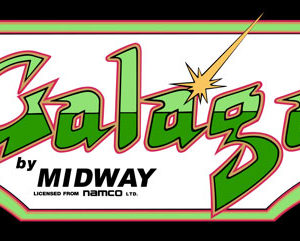 Galaga is a single-screen shoot-em-up in which the player controls a “fighter” spaceship and must defend the home planet against the on-coming hordes of alien invaders. The fighter can only move left and right along the bottom of the screen. Galaga aliens fly onto the screen in a variety of formations – dropping bombs as they do so – before forming troop lines at the top of the screen. Once a troop line is formed, the aliens separate and start attacking the player’s ship in ones, twos and threes. The top line “boss” aliens need to be shot twice before they are destroyed. The boss alien has a tractor beam that can capture the player’s fighter. A captured fighter changes color from white to red and stays with that particular boss Galaga until it’s destroyed. The fighter can be retrieved by destroying the boss Galaga that captured it, but players must be careful not to destroy the captured ship itself, or that ship is lost. A rescued fighter changes color back from red to white and links up with the player’s current fighter, doubling its fire power. As players progress through each screen, the speed and number of alien attacks increases. Alien formations also become more complex, making the aliens harder to shoot. Bonus fighters are awarded periodically throughout the game, as players reach specific point values (dictated by the “bonus life” dip-switch setting). Each enemy ship also has an assigned point value (see scoring below). The alien troop lines that form at the top of the screen are, from top to bottom: Boss Galaga, Butterflies (red/white bug ships) and Bees (blue/yellow bug ships). I cut my teeth on video games like this back in the ’80s. Pinball lost momentum in this era as video games ruled the arcade at this time.
Galaga is a single-screen shoot-em-up in which the player controls a “fighter” spaceship and must defend the home planet against the on-coming hordes of alien invaders. The fighter can only move left and right along the bottom of the screen. Galaga aliens fly onto the screen in a variety of formations – dropping bombs as they do so – before forming troop lines at the top of the screen. Once a troop line is formed, the aliens separate and start attacking the player’s ship in ones, twos and threes. The top line “boss” aliens need to be shot twice before they are destroyed. The boss alien has a tractor beam that can capture the player’s fighter. A captured fighter changes color from white to red and stays with that particular boss Galaga until it’s destroyed. The fighter can be retrieved by destroying the boss Galaga that captured it, but players must be careful not to destroy the captured ship itself, or that ship is lost. A rescued fighter changes color back from red to white and links up with the player’s current fighter, doubling its fire power. As players progress through each screen, the speed and number of alien attacks increases. Alien formations also become more complex, making the aliens harder to shoot. Bonus fighters are awarded periodically throughout the game, as players reach specific point values (dictated by the “bonus life” dip-switch setting). Each enemy ship also has an assigned point value (see scoring below). The alien troop lines that form at the top of the screen are, from top to bottom: Boss Galaga, Butterflies (red/white bug ships) and Bees (blue/yellow bug ships). I cut my teeth on video games like this back in the ’80s. Pinball lost momentum in this era as video games ruled the arcade at this time. -
 Galaxian (Gyarakushian?) is an arcade game that was developed by Namco and released in October 1979. It was published by Namco in Japan and imported to North America by Midway that December. A fixed shooter game in which the player controls a spaceship at the bottom of the screen, and shoots enemies descending in various directions, it was designed to compete with Taito Corporation’s successful earlier game Space Invaders (which was released in the previous year, and also imported to the US by Midway Games). The game was highly popular for Namco upon its release, and has been a focus of competitive gaming ever since. It spawned a successful sequel, Galaga, in 1981, and the lesser known Gaplus and Galaga ‘88 in 1984 and 1987 respectively, as well as many later ports and adaptations. Along with its immediate sequel, it was one of the most popular games during the golden age of arcade video games. Galaxian expanded on the formula pioneered by Space Invaders. As in the earlier game, Galaxian features a horde of attacking aliens that exchanged shots with the player. In contrast to Space Invaders, Galaxian added an element of drama by having the aliens periodically make kamikaze-like dives at the player’s ship, the Galaxip.[1] This made it the first game to feature enemies with individual personalities.[2] The game’s plot consists of a title screen that displayed the message “WE ARE THE GALAXIANS / MISSION: DESTROY ALIENS”.[3] Galaxian was very successful for Namco and introduced several “firsts”. Although not the first color video game, Galaxian took RGB color graphics a step further with multi-colored animated sprites and explosions, different colored fonts for the score and high score, the scrolling starfield, and graphic icons that show the number of lives left and how many stages the player had completed. It also features a crude theme song and more prominent background “music.” These elements combine to create a look and feel that would set the standard for arcade games in the 1980s such as Pac-Man. Gameplay The gameplay is relatively simple. Swarm after swarm of alien armies attack the player’s ship that moves left and right at the bottom of the wraparound screen. The ship can only have one shot on screen at a time. The player defeats one swarm, only to have it replaced by another more aggressive and challenging swarm in the next stage. A plain and repetitive starfield scrolls in the background.
Galaxian (Gyarakushian?) is an arcade game that was developed by Namco and released in October 1979. It was published by Namco in Japan and imported to North America by Midway that December. A fixed shooter game in which the player controls a spaceship at the bottom of the screen, and shoots enemies descending in various directions, it was designed to compete with Taito Corporation’s successful earlier game Space Invaders (which was released in the previous year, and also imported to the US by Midway Games). The game was highly popular for Namco upon its release, and has been a focus of competitive gaming ever since. It spawned a successful sequel, Galaga, in 1981, and the lesser known Gaplus and Galaga ‘88 in 1984 and 1987 respectively, as well as many later ports and adaptations. Along with its immediate sequel, it was one of the most popular games during the golden age of arcade video games. Galaxian expanded on the formula pioneered by Space Invaders. As in the earlier game, Galaxian features a horde of attacking aliens that exchanged shots with the player. In contrast to Space Invaders, Galaxian added an element of drama by having the aliens periodically make kamikaze-like dives at the player’s ship, the Galaxip.[1] This made it the first game to feature enemies with individual personalities.[2] The game’s plot consists of a title screen that displayed the message “WE ARE THE GALAXIANS / MISSION: DESTROY ALIENS”.[3] Galaxian was very successful for Namco and introduced several “firsts”. Although not the first color video game, Galaxian took RGB color graphics a step further with multi-colored animated sprites and explosions, different colored fonts for the score and high score, the scrolling starfield, and graphic icons that show the number of lives left and how many stages the player had completed. It also features a crude theme song and more prominent background “music.” These elements combine to create a look and feel that would set the standard for arcade games in the 1980s such as Pac-Man. Gameplay The gameplay is relatively simple. Swarm after swarm of alien armies attack the player’s ship that moves left and right at the bottom of the wraparound screen. The ship can only have one shot on screen at a time. The player defeats one swarm, only to have it replaced by another more aggressive and challenging swarm in the next stage. A plain and repetitive starfield scrolls in the background. -
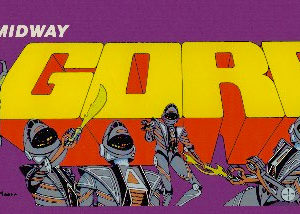 Gorf is an arcade game released in 1981 by Midway Mfg., whose name was advertised as an acronym for “Galactic Orbiting Robot Force”. It is a multiple-mission fixed shooter with five distinct modes of play, essentially making it five games in one. It is well known for its use of synthesized speech, a new feature at the time. The player controls a spaceship that can move left, right, up and down around the lower third of the screen. The ship can fire a single shot (called a “quark laser” in this game), which travels vertically up the screen. Unlike similar games, where the player cannot fire again until his existing shot has disappeared, the player can choose to fire another shot at any time; if the previous shot is still on screen, it disappears. Gorf consists of five distinct “missions”, each with its own patterns of enemies. The central goal of each mission is to destroy all enemies in that wave, which takes the player to the next mission. Successfully completing all five missions will increase the player’s rank and loop back to the first mission, where play continues on a higher difficulty level. The game continues until the player loses all their lives. The player can advance through the ranks of Space Cadet, Space Captain, Space Colonel, Space General, Space Warrior, and Space Avenger, with a higher difficulty level at each rank. Along the way, a robotic voice heckles and threatens the player, often calling the player by his current rank (for example, “Some galactic defender you are, Space Cadet!”). Some versions also display the player’s current rank via a series of lit panels in the cabinet. The missions are: 1.Astro Battles: The first mission is almost an exact clone of Space Invaders. This is the only mission that is not set in space, but rather against a sky-blue background. A small force of enemies (24 in Gorf vs. 55 in Space Invaders) attacks in the classic pattern set by the original game. The player is protected by a glittering parabolic force field that is gradually worn away by enemy fire. The force field switches off temporarily while the player’s shots pass through it. 2.Laser Attack: In this mission, the player must battle two formations of five enemies each. Each formation contains three yellow enemies that attempt to dive-bomb the player, a white gun that fires a single laser beam, and a red miniature version of the Gorf robot. 3.Galaxians: This mission is a clone of Galaxian, with the key differences being the number of enemies (24 in Gorf vs. 46 in Galaxian) and the way the enemies fire (pellets in Gorf, missiles in Galaxian). Gameplay is otherwise similar to the original game. 4.Space Warp: Mission 4 places the player in a sort of wormhole, where enemies fly outward from the center of the screen and attempt to either shoot down or collide with the player’s ship. It is possible to shoot enemy shots in this level. 5.Flag Ship: The Flag Ship is protected by its own force field (similar to the one protecting the player in Mission 1), and it flies back and forth and fires at the player. To defeat it, the player must break through the force field and destroy the ship’s core: if a different part of the ship is hit the player receives bonus points and the part breaks off and flies in a random direction, potentially posing a risk to the player’s ship. If the player successful hits the Flag Ship’s core, the Flag Ship explodes in a dramatic display, the player advances to the next rank, and play continues on Mission 1, with the difficulty increased.
Gorf is an arcade game released in 1981 by Midway Mfg., whose name was advertised as an acronym for “Galactic Orbiting Robot Force”. It is a multiple-mission fixed shooter with five distinct modes of play, essentially making it five games in one. It is well known for its use of synthesized speech, a new feature at the time. The player controls a spaceship that can move left, right, up and down around the lower third of the screen. The ship can fire a single shot (called a “quark laser” in this game), which travels vertically up the screen. Unlike similar games, where the player cannot fire again until his existing shot has disappeared, the player can choose to fire another shot at any time; if the previous shot is still on screen, it disappears. Gorf consists of five distinct “missions”, each with its own patterns of enemies. The central goal of each mission is to destroy all enemies in that wave, which takes the player to the next mission. Successfully completing all five missions will increase the player’s rank and loop back to the first mission, where play continues on a higher difficulty level. The game continues until the player loses all their lives. The player can advance through the ranks of Space Cadet, Space Captain, Space Colonel, Space General, Space Warrior, and Space Avenger, with a higher difficulty level at each rank. Along the way, a robotic voice heckles and threatens the player, often calling the player by his current rank (for example, “Some galactic defender you are, Space Cadet!”). Some versions also display the player’s current rank via a series of lit panels in the cabinet. The missions are: 1.Astro Battles: The first mission is almost an exact clone of Space Invaders. This is the only mission that is not set in space, but rather against a sky-blue background. A small force of enemies (24 in Gorf vs. 55 in Space Invaders) attacks in the classic pattern set by the original game. The player is protected by a glittering parabolic force field that is gradually worn away by enemy fire. The force field switches off temporarily while the player’s shots pass through it. 2.Laser Attack: In this mission, the player must battle two formations of five enemies each. Each formation contains three yellow enemies that attempt to dive-bomb the player, a white gun that fires a single laser beam, and a red miniature version of the Gorf robot. 3.Galaxians: This mission is a clone of Galaxian, with the key differences being the number of enemies (24 in Gorf vs. 46 in Galaxian) and the way the enemies fire (pellets in Gorf, missiles in Galaxian). Gameplay is otherwise similar to the original game. 4.Space Warp: Mission 4 places the player in a sort of wormhole, where enemies fly outward from the center of the screen and attempt to either shoot down or collide with the player’s ship. It is possible to shoot enemy shots in this level. 5.Flag Ship: The Flag Ship is protected by its own force field (similar to the one protecting the player in Mission 1), and it flies back and forth and fires at the player. To defeat it, the player must break through the force field and destroy the ship’s core: if a different part of the ship is hit the player receives bonus points and the part breaks off and flies in a random direction, potentially posing a risk to the player’s ship. If the player successful hits the Flag Ship’s core, the Flag Ship explodes in a dramatic display, the player advances to the next rank, and play continues on Mission 1, with the difficulty increased. -

-
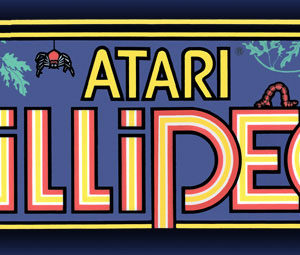 Similar to Centipede, the object of the game is to destroy a millipede that advances downward from the top of the screen. The millipede travels horizontally until it either hits an obstacle or reaches the edge of the screen, after which it drops one row and reverses direction. Once it enters the player’s gray maneuvering area, it stays there and extra heads appear at intervals until both they and the millipede are destroyed. Shooting a body segment splits the millipede in two, with the rear portion sprouting its own head. A collision with any enemy costs the player one life. New enemies and gameplay elements are introduced in Millipede: Earwig: same as the scorpion in Centipede, making mushrooms poisonous so that the millipede will charge straight to the bottom of the screen after touching them. Bee: same as the flea in Centipede, dropping mushrooms in a vertical line and requiring two shots to kill. Spider: same behavior as in Centipede, bouncing irregularly across the player area and eating mushrooms. Multiple spiders can appear at the same time on higher levels. Inchworm: when hit, slows all enemies for a short period of time. Beetle: crawls around the player area for a while, then climbs up and leaves the screen, turning any mushrooms it touches into indestructible flowers. When hit, everything on the screen scrolls down one row. Dragonfly: drops mushrooms while zigzagging down, and can be destroyed with a single shot. Mosquito: bounces off the sides of the screen as it descends diagonally. When hit, everything on the screen scrolls up one row. DDT bomb (stationary): can be blown up with one shot, destroying all enemies and mushrooms within the blast radius. Whenever the mushrooms scroll down, a new bomb is added at the top of the screen. Up to four bombs can be in play at one time. The player scores points for shooting the bomb itself, as well as increased values for any enemies destroyed in the blast. All flowers and poisoned/partially destroyed mushrooms revert to normal, whole mushrooms and score points during the process when the player loses a life. At regular intervals during the game, the player will face a swarm of enemies (bees, dragonflies, etc.) instead of the usual millipede. Each enemy destroyed awards increasing points, up to a maximum of 1,000 points per enemy; this attack ends when either the entire swarm has passed or the player loses a life. Also, at intervals new mushrooms will grow on the field while others die off, in a pattern similar to Conway’s Game of Life. Players can also choose at the start of the game whether to play at an advanced level, starting with a score that is a multiple of the number of points needed to earn an extra life (by default, 15,000). The gameplay is generally much more advanced than it would be had the player started with a score of 0 and worked their way up to that point level. The maximum advanced level allowed is a function of the preceding player’s score, and games started at an advanced level where the player did not earn at least one extra life are not eligible for the high scoreboard.
Similar to Centipede, the object of the game is to destroy a millipede that advances downward from the top of the screen. The millipede travels horizontally until it either hits an obstacle or reaches the edge of the screen, after which it drops one row and reverses direction. Once it enters the player’s gray maneuvering area, it stays there and extra heads appear at intervals until both they and the millipede are destroyed. Shooting a body segment splits the millipede in two, with the rear portion sprouting its own head. A collision with any enemy costs the player one life. New enemies and gameplay elements are introduced in Millipede: Earwig: same as the scorpion in Centipede, making mushrooms poisonous so that the millipede will charge straight to the bottom of the screen after touching them. Bee: same as the flea in Centipede, dropping mushrooms in a vertical line and requiring two shots to kill. Spider: same behavior as in Centipede, bouncing irregularly across the player area and eating mushrooms. Multiple spiders can appear at the same time on higher levels. Inchworm: when hit, slows all enemies for a short period of time. Beetle: crawls around the player area for a while, then climbs up and leaves the screen, turning any mushrooms it touches into indestructible flowers. When hit, everything on the screen scrolls down one row. Dragonfly: drops mushrooms while zigzagging down, and can be destroyed with a single shot. Mosquito: bounces off the sides of the screen as it descends diagonally. When hit, everything on the screen scrolls up one row. DDT bomb (stationary): can be blown up with one shot, destroying all enemies and mushrooms within the blast radius. Whenever the mushrooms scroll down, a new bomb is added at the top of the screen. Up to four bombs can be in play at one time. The player scores points for shooting the bomb itself, as well as increased values for any enemies destroyed in the blast. All flowers and poisoned/partially destroyed mushrooms revert to normal, whole mushrooms and score points during the process when the player loses a life. At regular intervals during the game, the player will face a swarm of enemies (bees, dragonflies, etc.) instead of the usual millipede. Each enemy destroyed awards increasing points, up to a maximum of 1,000 points per enemy; this attack ends when either the entire swarm has passed or the player loses a life. Also, at intervals new mushrooms will grow on the field while others die off, in a pattern similar to Conway’s Game of Life. Players can also choose at the start of the game whether to play at an advanced level, starting with a score that is a multiple of the number of points needed to earn an extra life (by default, 15,000). The gameplay is generally much more advanced than it would be had the player started with a score of 0 and worked their way up to that point level. The maximum advanced level allowed is a function of the preceding player’s score, and games started at an advanced level where the player did not earn at least one extra life are not eligible for the high scoreboard. -
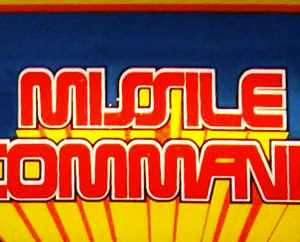 Missile Command is a 1980 arcade game by Atari, Inc. that was also licensed to Sega for European release. It is considered one of the most notable games from the Golden Age of Video Arcade Games. The plot of Missile Command is simple: the player’s six cities are being attacked by an endless hail of ballistic missiles, some of them even splitting like multiple independently targetable reentry vehicles (MIRVs), and in later levels smart bombs which can evade a less than perfectly targeted missile. As a regional commander of three anti-missile batteries, the player must defend six cities in their zone from being destroyed. The game is played by moving a crosshair across the sky background via a trackball and pressing one of three buttons to launch a counter-missile from the appropriate battery. Counter-missiles explode upon reaching the crosshair, leaving a fireball that persists for several seconds and destroys any enemy missiles that enter it. There are three batteries, each with ten missiles; a missile battery becomes useless when all its missiles are fired, or if the battery is destroyed by enemy fire. The missiles of the central battery fly to their targets at much greater speed; only these missiles can effectively kill a smart bomb at a distance. The game is staged as a series of levels of increasing difficulty; each level contains a set number of incoming enemy weapons. The weapons attack the six cities, as well as the missile batteries; being struck by an enemy weapon results in destruction of the city or missile battery. Enemy weapons are only able to destroy 3 cities during one level. A level ends if all the cities are destroyed, or when all enemy weaponry is destroyed or reaches its target. A player who runs out of missiles no longer has control over the remainder of the level. At the conclusion of a level, the player receives bonus points for any remaining cities or unused missiles. Between levels missile batteries are rebuilt and replenished; destroyed cities are rebuilt only at set point levels (usually 10 or 12K). The game inevitably ends when all six cities have been wiped out. Like most early arcade games, there is no way to “win” the game; the game just keeps going with ever faster and more prolific incoming missiles. The game, then, is just a contest in seeing how long the player can survive. On conclusion of the game, the screen displays “The End”, perhaps a poke at oncoming Nuclear Holocaust rather than the standard “Game Over” text (however, if the player is able to make the high score list, the game then prompts the player to enter his/her initials, with the “The End” sequence skipped). The game features an interesting bug: once a score of 810,000 is reached, a large number of cities are awarded (176 cities plus the continuing accrual of bonus cities) and it is possible to carry on playing for several hours. At some later stage the speed of missiles increases greatly for a few screens. On the 255th and 256th yellow screens, known as the 0x stages, the scoring increases by 256 times the base value. For good players these two 0x stages could earn over a million points. This enabled them to reach a score of approximately 2,800,000 (although only 6 digit scores were shown, so it would display 800,000) and at this point the accelerated rate would suddenly cease and the game would restart at its original (slow) speed and return to the first stage, but with the score and any saved cities retained. In this way it was possible to play this game for hours on end. Targeting crosshair: Aim your missiles quickly but carefully. Use the trackball to move the targeting crosshair to where you want the next missile to go, then press any Launch Control button to fire the missile. The missile will explode where the crosshair was positioned when the Launch Control button was pressed. Cities: There are six cities in total on the screen at one time, three on either side of the Delta Base. If one enemy missile or Smart Bomb manages to strike a city, that city will be wiped out. When all cities are destroyed, the game is over. Alpha Base: The missile base on the left side of the screen. Press the leftmost Launch Control button to launch an ABM from the Alpha Base. Delta Base: The missile base in the center of the screen. Press the middle Launch Control button to launch an ABM from the Delta Base. Omega Base: The missile base on the right side of the screen. Press the rightmost Launch Control button to launch an ABM from the Omega Base. NOTE: The Alpha and Omega Bases launch ABMs at a slower speed than the Delta Base, so you must plan further ahead when launching missiles from those bases. Defensive Missiles : The ABMs you launch to protect your cities. Each missile base contains 10 ABMs per wave. If any missile base is struck by an attack missile or smart bomb, the remaining stock of missiles for that wave are destroyed, and the missile base is rendered useless until the next wave. You receive bonus points for every ABM you have remaining at the end of each wave. Attack Missiles : Their only aim is to destroy your cities and missile bases. Every missile wave starts off with a hailstorm of attack missiles. They never deviate from their path. They may, however, turn into MIRVs. MIRV : Surprise! There is no warning when an attack missile turns into an MIRV (with multiple warheads). Think fast. Each new missile that the MIRV unleashes is carefully targeted. Killer Satellite: A mean-looking satellite that travels across the sky at a mid-level altitude and fires attack missiles. First appears in Wave 2. Bomber: A big slow-moving target that flies across the sky at a mid-level altitude, but watch out! It fires attack missiles. First appears in Wave 2. WARNING: If you destory a bomber or killer satellite before they deploy their missiles, you may see their missiles added to the downpour. An existing missile may also turn into an MIRV. Smart Bomb: Smart enough to avoid most explosion clouds from your ABMs. Your ABM must explode next to one in order to destroy it. You can also squeen it between two explosions to destroy it. First appears in Wave 5. ‘LOW’ Warning: As soon as there are only three ABMs left in a missile base, the game displays the word “LOW” underneath that base, and a warning signal sounds. Heed the warning.
Missile Command is a 1980 arcade game by Atari, Inc. that was also licensed to Sega for European release. It is considered one of the most notable games from the Golden Age of Video Arcade Games. The plot of Missile Command is simple: the player’s six cities are being attacked by an endless hail of ballistic missiles, some of them even splitting like multiple independently targetable reentry vehicles (MIRVs), and in later levels smart bombs which can evade a less than perfectly targeted missile. As a regional commander of three anti-missile batteries, the player must defend six cities in their zone from being destroyed. The game is played by moving a crosshair across the sky background via a trackball and pressing one of three buttons to launch a counter-missile from the appropriate battery. Counter-missiles explode upon reaching the crosshair, leaving a fireball that persists for several seconds and destroys any enemy missiles that enter it. There are three batteries, each with ten missiles; a missile battery becomes useless when all its missiles are fired, or if the battery is destroyed by enemy fire. The missiles of the central battery fly to their targets at much greater speed; only these missiles can effectively kill a smart bomb at a distance. The game is staged as a series of levels of increasing difficulty; each level contains a set number of incoming enemy weapons. The weapons attack the six cities, as well as the missile batteries; being struck by an enemy weapon results in destruction of the city or missile battery. Enemy weapons are only able to destroy 3 cities during one level. A level ends if all the cities are destroyed, or when all enemy weaponry is destroyed or reaches its target. A player who runs out of missiles no longer has control over the remainder of the level. At the conclusion of a level, the player receives bonus points for any remaining cities or unused missiles. Between levels missile batteries are rebuilt and replenished; destroyed cities are rebuilt only at set point levels (usually 10 or 12K). The game inevitably ends when all six cities have been wiped out. Like most early arcade games, there is no way to “win” the game; the game just keeps going with ever faster and more prolific incoming missiles. The game, then, is just a contest in seeing how long the player can survive. On conclusion of the game, the screen displays “The End”, perhaps a poke at oncoming Nuclear Holocaust rather than the standard “Game Over” text (however, if the player is able to make the high score list, the game then prompts the player to enter his/her initials, with the “The End” sequence skipped). The game features an interesting bug: once a score of 810,000 is reached, a large number of cities are awarded (176 cities plus the continuing accrual of bonus cities) and it is possible to carry on playing for several hours. At some later stage the speed of missiles increases greatly for a few screens. On the 255th and 256th yellow screens, known as the 0x stages, the scoring increases by 256 times the base value. For good players these two 0x stages could earn over a million points. This enabled them to reach a score of approximately 2,800,000 (although only 6 digit scores were shown, so it would display 800,000) and at this point the accelerated rate would suddenly cease and the game would restart at its original (slow) speed and return to the first stage, but with the score and any saved cities retained. In this way it was possible to play this game for hours on end. Targeting crosshair: Aim your missiles quickly but carefully. Use the trackball to move the targeting crosshair to where you want the next missile to go, then press any Launch Control button to fire the missile. The missile will explode where the crosshair was positioned when the Launch Control button was pressed. Cities: There are six cities in total on the screen at one time, three on either side of the Delta Base. If one enemy missile or Smart Bomb manages to strike a city, that city will be wiped out. When all cities are destroyed, the game is over. Alpha Base: The missile base on the left side of the screen. Press the leftmost Launch Control button to launch an ABM from the Alpha Base. Delta Base: The missile base in the center of the screen. Press the middle Launch Control button to launch an ABM from the Delta Base. Omega Base: The missile base on the right side of the screen. Press the rightmost Launch Control button to launch an ABM from the Omega Base. NOTE: The Alpha and Omega Bases launch ABMs at a slower speed than the Delta Base, so you must plan further ahead when launching missiles from those bases. Defensive Missiles : The ABMs you launch to protect your cities. Each missile base contains 10 ABMs per wave. If any missile base is struck by an attack missile or smart bomb, the remaining stock of missiles for that wave are destroyed, and the missile base is rendered useless until the next wave. You receive bonus points for every ABM you have remaining at the end of each wave. Attack Missiles : Their only aim is to destroy your cities and missile bases. Every missile wave starts off with a hailstorm of attack missiles. They never deviate from their path. They may, however, turn into MIRVs. MIRV : Surprise! There is no warning when an attack missile turns into an MIRV (with multiple warheads). Think fast. Each new missile that the MIRV unleashes is carefully targeted. Killer Satellite: A mean-looking satellite that travels across the sky at a mid-level altitude and fires attack missiles. First appears in Wave 2. Bomber: A big slow-moving target that flies across the sky at a mid-level altitude, but watch out! It fires attack missiles. First appears in Wave 2. WARNING: If you destory a bomber or killer satellite before they deploy their missiles, you may see their missiles added to the downpour. An existing missile may also turn into an MIRV. Smart Bomb: Smart enough to avoid most explosion clouds from your ABMs. Your ABM must explode next to one in order to destroy it. You can also squeen it between two explosions to destroy it. First appears in Wave 5. ‘LOW’ Warning: As soon as there are only three ABMs left in a missile base, the game displays the word “LOW” underneath that base, and a warning signal sounds. Heed the warning. -
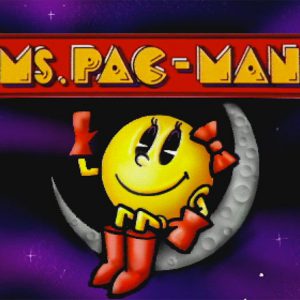 In this, the first proper sequel to Namco’s legendary pill-eating maze game, players must once again run around a number of mazes, eating all of the pills that are scattered throughout. The ever-present ghosts (Blinky, Pinky, Inky and Sue) return to hamper the player’s progress. The infamous “power pills” are also present and correct, with four appearing in each maze. Namco introduced a number of changes and enhancements over the original game. The first difference is in the main character. For the first time in video-game history, the game’s lead character was female. Ms. Pac-man is almost identical to the original character with two main differences: she wears a bow in her “hair” and is also wearing lipstick. Another change from the original is that the bonus fruit items are no longer static but now move randomly around the mazes. Ms. Pac-man features four different maze layouts, which alternate every two to four screens: the first maze is only encountered in rounds 1 and 2 and has 220 dots and four power pills. There are two sets of tunnels in this maze equidistant from the center of the maze. You must clear this maze twice before moving on to the next maze. The second maze is only encountered in rounds 3, 4, and 5, and has 240 dots and four power pills. There are two sets of tunnels in this maze: one set in the lower half, and the other set at the very top. You must clear this maze three times before moving on to the next maze. The third maze is first encountered in round 6 and has 238 dots and four power pills. Unlike all other mazes, there is only one set of tunnels in this maze, slightly above the center of the board. You must clear this maze four times before moving on to the next maze. The fourth and final unique maze is first encountered in round 10 and has 234 dots and four power pills. There are two sets of tunnels in this maze, directly next to one another in the middle of the maze. The turns at the entrance to the tunnels change the usual immediate accessibility of the tunnels and should be taken into account. You must clear this maze four times before moving on to the next maze.
In this, the first proper sequel to Namco’s legendary pill-eating maze game, players must once again run around a number of mazes, eating all of the pills that are scattered throughout. The ever-present ghosts (Blinky, Pinky, Inky and Sue) return to hamper the player’s progress. The infamous “power pills” are also present and correct, with four appearing in each maze. Namco introduced a number of changes and enhancements over the original game. The first difference is in the main character. For the first time in video-game history, the game’s lead character was female. Ms. Pac-man is almost identical to the original character with two main differences: she wears a bow in her “hair” and is also wearing lipstick. Another change from the original is that the bonus fruit items are no longer static but now move randomly around the mazes. Ms. Pac-man features four different maze layouts, which alternate every two to four screens: the first maze is only encountered in rounds 1 and 2 and has 220 dots and four power pills. There are two sets of tunnels in this maze equidistant from the center of the maze. You must clear this maze twice before moving on to the next maze. The second maze is only encountered in rounds 3, 4, and 5, and has 240 dots and four power pills. There are two sets of tunnels in this maze: one set in the lower half, and the other set at the very top. You must clear this maze three times before moving on to the next maze. The third maze is first encountered in round 6 and has 238 dots and four power pills. Unlike all other mazes, there is only one set of tunnels in this maze, slightly above the center of the board. You must clear this maze four times before moving on to the next maze. The fourth and final unique maze is first encountered in round 10 and has 234 dots and four power pills. There are two sets of tunnels in this maze, directly next to one another in the middle of the maze. The turns at the entrance to the tunnels change the usual immediate accessibility of the tunnels and should be taken into account. You must clear this maze four times before moving on to the next maze. -
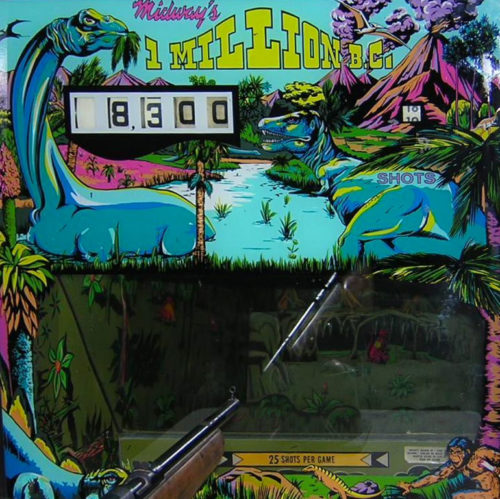
-
 It’s probably a very rare person who has never played Pac-Man. Even for those who may have missed it in the 1980s, Pac-Man has been re-made on nearly every video game platform since then. Pac-Man even appeared on the front page of Google (as a playable game) on Pac-Man’s 30th anniversary. However, for those few who are unfamiliar with the game, here are the basics. You, the player, control the yellow, circular Pac-Man using either keyboard arrows or a joystick. The goal is to move Pac-Man around the maze-like screen gobbling up all 240 dots before the four ghosts (sometimes called monsters) get you. The four ghosts are all different colors: Blinky (red), Inky (light blue), Pinky (pink), and Clyde (orange). However, they all turn dark blue when Pac-Man eats one of the four power pellets available on each level; the pellets enable Pac-Man to eat the ghosts. Occasionally, fruit will appear on the screen. If Pac-Man gobbles those up then he earns a point bonus, with different fruit worth different values. While all this is happening, Pac-Man makes a wocka-wocka sound that is nearly as memorable as the yellow character himself. When first launched in Japan by Namco in 1980, the game received a lukewarm response, as Space Invaders and other similar games were more popular at the time. However, the game found far more success in North America. Pac-Man’s success in North America took competitors and distributors completely by surprise in 1980. Marketing executives who saw Pac-Man at a trade show prior to release completely overlooked the game (along with the now-classic Defender), while they looked to a racing car game called Rally-X as the game to outdo that year. The appeal of Pac-Man was such that the game caught on immediately with the public; it quickly became far more popular than anything seen in the game industry up to that point. Pac-Man outstripped Asteroids as the best-selling arcade game in North America, grossing over $1 billion in quarters within a decade, by the end of the 1980s, surpassing the revenues grossed by the highest-grossing film “Star Wars”. The player controls Pac-Man through a maze, eating pac-dots (also called pellets). When all pac-dots are eaten, Pac-Man is taken to the next stage. Between some stages one of three intermission animations plays. Four enemies (Blinky, Pinky, Inky and Clyde) roam the maze, trying to catch Pac-Man. If an enemy touches Pac-Man, a life is lost and the Pac-Man itself withers and dies. When all lives have been lost, the game ends. Pac-Man is awarded a single bonus life at 10,000 points by default.
It’s probably a very rare person who has never played Pac-Man. Even for those who may have missed it in the 1980s, Pac-Man has been re-made on nearly every video game platform since then. Pac-Man even appeared on the front page of Google (as a playable game) on Pac-Man’s 30th anniversary. However, for those few who are unfamiliar with the game, here are the basics. You, the player, control the yellow, circular Pac-Man using either keyboard arrows or a joystick. The goal is to move Pac-Man around the maze-like screen gobbling up all 240 dots before the four ghosts (sometimes called monsters) get you. The four ghosts are all different colors: Blinky (red), Inky (light blue), Pinky (pink), and Clyde (orange). However, they all turn dark blue when Pac-Man eats one of the four power pellets available on each level; the pellets enable Pac-Man to eat the ghosts. Occasionally, fruit will appear on the screen. If Pac-Man gobbles those up then he earns a point bonus, with different fruit worth different values. While all this is happening, Pac-Man makes a wocka-wocka sound that is nearly as memorable as the yellow character himself. When first launched in Japan by Namco in 1980, the game received a lukewarm response, as Space Invaders and other similar games were more popular at the time. However, the game found far more success in North America. Pac-Man’s success in North America took competitors and distributors completely by surprise in 1980. Marketing executives who saw Pac-Man at a trade show prior to release completely overlooked the game (along with the now-classic Defender), while they looked to a racing car game called Rally-X as the game to outdo that year. The appeal of Pac-Man was such that the game caught on immediately with the public; it quickly became far more popular than anything seen in the game industry up to that point. Pac-Man outstripped Asteroids as the best-selling arcade game in North America, grossing over $1 billion in quarters within a decade, by the end of the 1980s, surpassing the revenues grossed by the highest-grossing film “Star Wars”. The player controls Pac-Man through a maze, eating pac-dots (also called pellets). When all pac-dots are eaten, Pac-Man is taken to the next stage. Between some stages one of three intermission animations plays. Four enemies (Blinky, Pinky, Inky and Clyde) roam the maze, trying to catch Pac-Man. If an enemy touches Pac-Man, a life is lost and the Pac-Man itself withers and dies. When all lives have been lost, the game ends. Pac-Man is awarded a single bonus life at 10,000 points by default. -
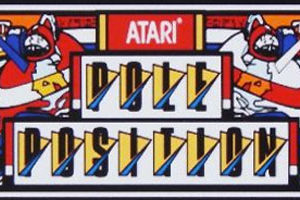 Gameplay of Pole Position. In this game, the player controls a Formula One race car, and has to complete a time trial lap within a certain amount of time (between 90 and 120 seconds) to qualify for an F1 race at the Fuji Racetrack. After qualifying, the player races against seven other CPU-controlled cars in a championship race (but if he or she does not qualify, the car will stay on the track until the timer runs out). The player must also avoid going off the road so that he or she will not crash into the billboards. Pole Position was the first racing video game to feature a track based on a real racing circuit. It was also the first game to feature a qualifying lap, requiring the player to complete a time trial before they can compete in Grand Prix races. Once the player has qualified, they must complete the race in the time allowed, avoiding collisions with CPU-controlled opponents and billboards along the sides of the track. The game’s publisher Atari publicized the game for its “unbelievable driving realism” in providing a Formula 1 experience behind a racing wheel. The game’s graphics featured full-color landscapes with scaling sprites, including race cars and other signs, and a pseudo-3D, third-person, rear perspective view of the track, with its vanishing point swaying side to side as the player approaches corners, accurately simulating forward movement into the distance.
Gameplay of Pole Position. In this game, the player controls a Formula One race car, and has to complete a time trial lap within a certain amount of time (between 90 and 120 seconds) to qualify for an F1 race at the Fuji Racetrack. After qualifying, the player races against seven other CPU-controlled cars in a championship race (but if he or she does not qualify, the car will stay on the track until the timer runs out). The player must also avoid going off the road so that he or she will not crash into the billboards. Pole Position was the first racing video game to feature a track based on a real racing circuit. It was also the first game to feature a qualifying lap, requiring the player to complete a time trial before they can compete in Grand Prix races. Once the player has qualified, they must complete the race in the time allowed, avoiding collisions with CPU-controlled opponents and billboards along the sides of the track. The game’s publisher Atari publicized the game for its “unbelievable driving realism” in providing a Formula 1 experience behind a racing wheel. The game’s graphics featured full-color landscapes with scaling sprites, including race cars and other signs, and a pseudo-3D, third-person, rear perspective view of the track, with its vanishing point swaying side to side as the player approaches corners, accurately simulating forward movement into the distance. -

-
 Atari PONG was released in June 1972 and is the first commercially successful video game and is based on a simple two-dimensional graphical representation of a tennis-like game. Players use paddles to hit a ball back and forth on a black and white screen. Pong was the first game developed by Atari Inc., by Nolan Bushnell and Ted Dabney. Pong (marketed as PONG) is one of the earliest arcade video games, and is a tennis sports game featuring simple two-dimensional graphics. The player controls an in-game paddle by moving it vertically across the left side of the screen, and can compete against either a computer controlled opponent or another player controlling a second paddle on the opposing side. Players use the paddles to hit a ball back and forth. The aim is for a player to earn more points than the opponent; points are earned when one fails to return the ball to the other. Pong consistently earned four times more revenue than other coin-operated machines, which resulted in an increase in the number of orders Atari received. This provided Atari with a steady source of income; the company sold the machines at three times the cost of production. By 1973, the company had filled 2,500 orders, and, at the end of 1974, sold more than 8,000 units.[20] The arcade cabinets have since become collector’s items with the cocktail-table version being the rarest. Atari eventually sold more than 35,000 units, however, many more imitations were produced by competitors.
Atari PONG was released in June 1972 and is the first commercially successful video game and is based on a simple two-dimensional graphical representation of a tennis-like game. Players use paddles to hit a ball back and forth on a black and white screen. Pong was the first game developed by Atari Inc., by Nolan Bushnell and Ted Dabney. Pong (marketed as PONG) is one of the earliest arcade video games, and is a tennis sports game featuring simple two-dimensional graphics. The player controls an in-game paddle by moving it vertically across the left side of the screen, and can compete against either a computer controlled opponent or another player controlling a second paddle on the opposing side. Players use the paddles to hit a ball back and forth. The aim is for a player to earn more points than the opponent; points are earned when one fails to return the ball to the other. Pong consistently earned four times more revenue than other coin-operated machines, which resulted in an increase in the number of orders Atari received. This provided Atari with a steady source of income; the company sold the machines at three times the cost of production. By 1973, the company had filled 2,500 orders, and, at the end of 1974, sold more than 8,000 units.[20] The arcade cabinets have since become collector’s items with the cocktail-table version being the rarest. Atari eventually sold more than 35,000 units, however, many more imitations were produced by competitors. -
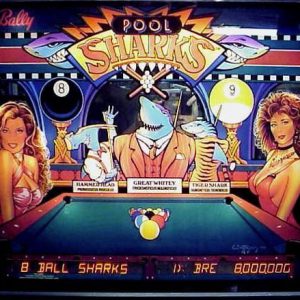
-
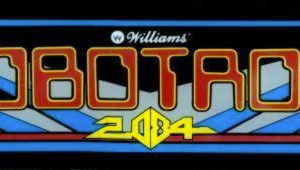
-
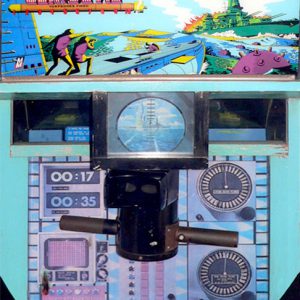 This was one of my favorite arcade machines in its heyday. Midway found much success with this one-player machine. A faux periscope is the viewing platform for action in this battle to sink enemy ships. You are allowed a fixed number of torpedoes per game to sink as much tonnage as possible per outing. A perfect game awards bonus torpedoes. The lighting effects and sounds are wonderful for their day. You’re allowed to “steer” your torpedo to about one-fourth of theway to your enemy. Giving just the right amount of lead time to each ship is critical. Some shipsare faster than others and these sinkings award more points. Go ahead, captain, sink the fleet!
This was one of my favorite arcade machines in its heyday. Midway found much success with this one-player machine. A faux periscope is the viewing platform for action in this battle to sink enemy ships. You are allowed a fixed number of torpedoes per game to sink as much tonnage as possible per outing. A perfect game awards bonus torpedoes. The lighting effects and sounds are wonderful for their day. You’re allowed to “steer” your torpedo to about one-fourth of theway to your enemy. Giving just the right amount of lead time to each ship is critical. Some shipsare faster than others and these sinkings award more points. Go ahead, captain, sink the fleet! -
 Sharp Shooter is an EM Rifle game. The shooter can choose from a variety of targets in a well-decorated range, which uses black lights to make some interesting pictures. The shooter can choose from candles, tumbling acrobats, bicycle-riding clowns, ducks and a bonus bullseye. The candles are worth 200 points; the bonus target switches from 100-200-300 points; and the other targets vary shot by shot from 30-50-100 points. The game has provisions for setting the replay score, number of shots per game and a random-miss factor and a recoil solenoid. The game also has electronic sounds such as ducks quacking.
Sharp Shooter is an EM Rifle game. The shooter can choose from a variety of targets in a well-decorated range, which uses black lights to make some interesting pictures. The shooter can choose from candles, tumbling acrobats, bicycle-riding clowns, ducks and a bonus bullseye. The candles are worth 200 points; the bonus target switches from 100-200-300 points; and the other targets vary shot by shot from 30-50-100 points. The game has provisions for setting the replay score, number of shots per game and a random-miss factor and a recoil solenoid. The game also has electronic sounds such as ducks quacking. -

-
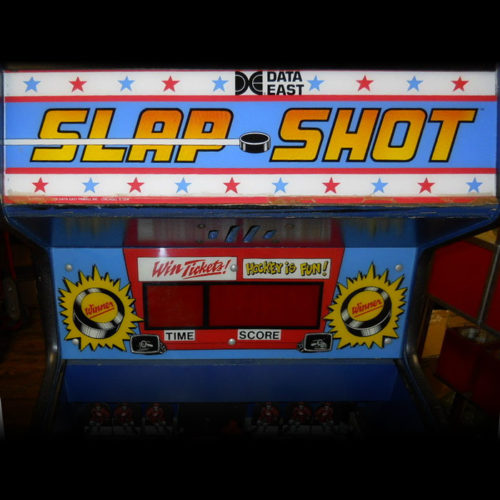
-
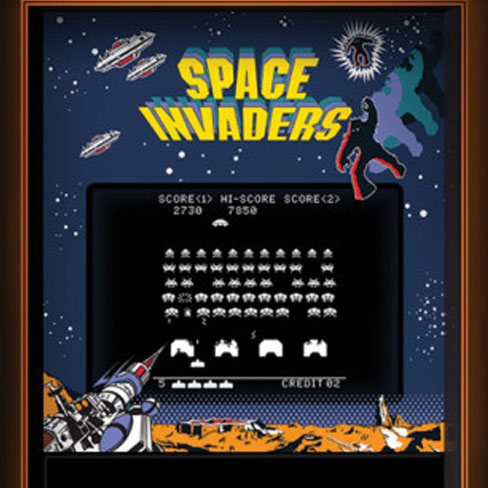
-
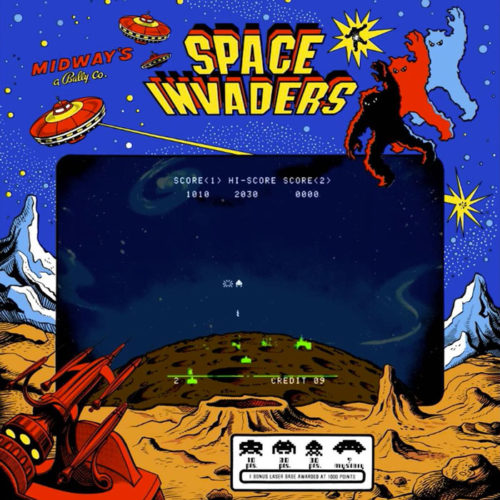
-
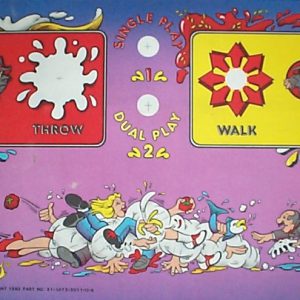
-
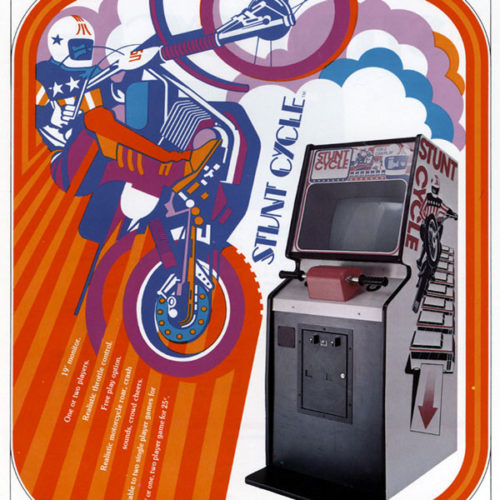
-
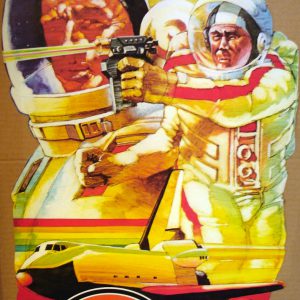 Move a paddle back and forth at the bottom of the screen to rebound a ball back into a brick wall, knocking bricks out one by one. There are three separate games: double — same as Breakout, knock down bricks and when they are all gone a new wall forms cavity — two other balls are inside the wall, when they have an escape route you can hit them as well progressive — as the wall is destroyed, new bricks are added and the entire wall shifts down toward your paddle. The sound effects are just simple beeps. This video game is a typical late ’70s machine which has been reproduced in many variations as well as downloaded apps on smartphones today. No complicated rules here, which is why it was so popular in its glory days. You control the horizontal paddle at the bottom of the playfield and, through the use of the spin controller, try to prevent losing the “ball” below the paddle. By aiming at the bricks, you try to hit all of them and then “break through” to the next layer of bricks. This accomplishment is rewarded with a period of high scoring and ricocheting video bounces of the “ball” until it escapes the brick layer and comes into your paddle again. These brick layers then start to drop toward your paddle. By the way, the TV is black and white!
Move a paddle back and forth at the bottom of the screen to rebound a ball back into a brick wall, knocking bricks out one by one. There are three separate games: double — same as Breakout, knock down bricks and when they are all gone a new wall forms cavity — two other balls are inside the wall, when they have an escape route you can hit them as well progressive — as the wall is destroyed, new bricks are added and the entire wall shifts down toward your paddle. The sound effects are just simple beeps. This video game is a typical late ’70s machine which has been reproduced in many variations as well as downloaded apps on smartphones today. No complicated rules here, which is why it was so popular in its glory days. You control the horizontal paddle at the bottom of the playfield and, through the use of the spin controller, try to prevent losing the “ball” below the paddle. By aiming at the bricks, you try to hit all of them and then “break through” to the next layer of bricks. This accomplishment is rewarded with a period of high scoring and ricocheting video bounces of the “ball” until it escapes the brick layer and comes into your paddle again. These brick layers then start to drop toward your paddle. By the way, the TV is black and white! -
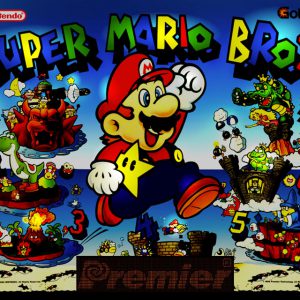 The player controls Mario throughout the Mushroom Kingdom. Mario’s abilities can be changed by picking up certain items; for example, Mario is able to shoot fireballs if he picks up a Fire Flower. The player takes on the role of the main protagonist of the series, Mario. Mario’s slightly younger brother, Luigi, is only playable by the second player in the game’s multiplayer mode, and assumes the same plot role as Mario. The objective is to race through the Mushroom Kingdom, survive the main antagonist Bowser?s forces and save Princess Toadstool. The player moves from the left side of the screen to the right side in order to reach the flag pole at the end of each level. A prevalent rumor that it is possible to jump over the flag pole was later confirmed by GameTrailers. The game world has coins scattered around it for Mario to collect, and special bricks marked with a question mark (“?”), which when hit from below by Mario, may reveal more coins or a special item. Other “secret” (often invisible) bricks may contain more coins or rare items. If the player gains a red and yellow Super Mushroom, Mario grows to double his size and can take one extra hit from most enemies and obstacles, in addition to being able to break bricks above him. Players are given a certain number of lives (and may gain additional lives by picking up green and orange ‘1-Up’ mushrooms, collecting 100 coins, or defeating several enemies in a row with a Koopa shell), which are lost when Mario takes too much damage, falls in a pit, or runs out of time; the game ends when all lives are lost. Mario’s primary attack is jumping on top of enemies, though many enemies have differing responses to this. For example, a Goomba will flatten and be defeated, while a Koopa Troopa will temporarily retract into its shell, allowing Mario to use it as a projectile. These shells may be deflected off a wall to destroy other enemies, though they can also bounce back against Mario, which will hurt or kill him. An alternate way to damage enemies is with the Fire Flower, an item which, when picked up, changes the color of Mario’s outfit (or only increases his size if a red and yellow mushroom had not been used previously) and allows him to shoot fireballs. A less common item is the Starman, which often appears from concealed or otherwise invisible blocks. This makes Mario temporarily invincible to most hazards and capable of defeating enemies on contact. The game consists of eight worlds with four sub-levels called “stages” in each world. The final stage of each world takes place in a castle where Bowser or one of his decoys are fought. The game also includes some stages taking place underwater, which contain different enemies. In addition, there are bonuses and secret areas in the game. Most secret areas contain more coins for Mario to collect, but others may contain “warp pipes” which allow Mario to advance to later worlds in the game, skipping over earlier ones.
The player controls Mario throughout the Mushroom Kingdom. Mario’s abilities can be changed by picking up certain items; for example, Mario is able to shoot fireballs if he picks up a Fire Flower. The player takes on the role of the main protagonist of the series, Mario. Mario’s slightly younger brother, Luigi, is only playable by the second player in the game’s multiplayer mode, and assumes the same plot role as Mario. The objective is to race through the Mushroom Kingdom, survive the main antagonist Bowser?s forces and save Princess Toadstool. The player moves from the left side of the screen to the right side in order to reach the flag pole at the end of each level. A prevalent rumor that it is possible to jump over the flag pole was later confirmed by GameTrailers. The game world has coins scattered around it for Mario to collect, and special bricks marked with a question mark (“?”), which when hit from below by Mario, may reveal more coins or a special item. Other “secret” (often invisible) bricks may contain more coins or rare items. If the player gains a red and yellow Super Mushroom, Mario grows to double his size and can take one extra hit from most enemies and obstacles, in addition to being able to break bricks above him. Players are given a certain number of lives (and may gain additional lives by picking up green and orange ‘1-Up’ mushrooms, collecting 100 coins, or defeating several enemies in a row with a Koopa shell), which are lost when Mario takes too much damage, falls in a pit, or runs out of time; the game ends when all lives are lost. Mario’s primary attack is jumping on top of enemies, though many enemies have differing responses to this. For example, a Goomba will flatten and be defeated, while a Koopa Troopa will temporarily retract into its shell, allowing Mario to use it as a projectile. These shells may be deflected off a wall to destroy other enemies, though they can also bounce back against Mario, which will hurt or kill him. An alternate way to damage enemies is with the Fire Flower, an item which, when picked up, changes the color of Mario’s outfit (or only increases his size if a red and yellow mushroom had not been used previously) and allows him to shoot fireballs. A less common item is the Starman, which often appears from concealed or otherwise invisible blocks. This makes Mario temporarily invincible to most hazards and capable of defeating enemies on contact. The game consists of eight worlds with four sub-levels called “stages” in each world. The final stage of each world takes place in a castle where Bowser or one of his decoys are fought. The game also includes some stages taking place underwater, which contain different enemies. In addition, there are bonuses and secret areas in the game. Most secret areas contain more coins for Mario to collect, but others may contain “warp pipes” which allow Mario to advance to later worlds in the game, skipping over earlier ones. -

-
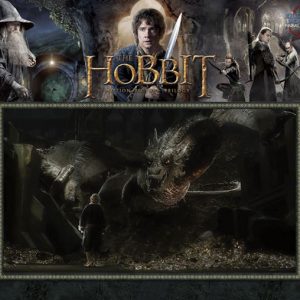 •27” HD LCD Display featuring full color custom animation, movie clips, scoring, attract mode, back glass artwork and more.. •Standard stainless steel spring-loaded metal lockdown bar and side armor •RGB-LED Playfield Lighting •Super-White LED GI Lighting •Full color digitally printed cabinet and back box artwork •7 Speaker 2.1 Digital Audio system. •Each game will have a number affixed to the game apron to be seen under the playfield glass… •Premium Clear Coated Playfield
•27” HD LCD Display featuring full color custom animation, movie clips, scoring, attract mode, back glass artwork and more.. •Standard stainless steel spring-loaded metal lockdown bar and side armor •RGB-LED Playfield Lighting •Super-White LED GI Lighting •Full color digitally printed cabinet and back box artwork •7 Speaker 2.1 Digital Audio system. •Each game will have a number affixed to the game apron to be seen under the playfield glass… •Premium Clear Coated Playfield